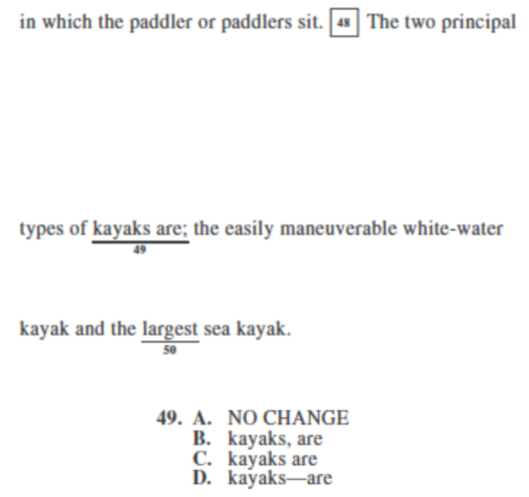Guide to ACT Punctuation Rules + Practice Questions
What’s Covered:
- ACT Punctuation Rules + Practice Questions
- How To Prepare
- How Does Your ACT Score Impact Your College Chances?
Are you studying for the ACT? Do you need to brush up on your punctuation rules? This guide is for you! We’ll go over what types of punctuation are tested within the English Test, how to use each form effectively, and share practice questions to make sure you’re getting everything right. Let’s get started!
Overview of ACT English Test
The ACT English is a multiple-choice exam. It contains 75 questions to be answered in 45 minutes. The most important punctuation rules tested on the ACT include commas and semicolons.
It’s important to understand why punctuation is tested on the ACT English Test. Especially when it comes to punctuation, students tend to focus on what sounds right and choose how they think a sentence should be written. To a certain degree, you should consider how a sentence would sound if spoken aloud or in your head, but this is not the main focus on punctuation. Instead, punctuation is tested to see if students are able to follow specific rules.
For example, commas are used before coordinating conjunctions within a list (and, or) and after the salutation in a letter. Additionally, semicolons separate items that have commas within them and separate independent clauses when there is no conjunction. In the next section, we’ll go over how to use each form of punctuation and provide examples.
Don’t feel like you need to know every rule off the top of your head. We’re going to cover all of them in this guide!
ACT Punctuation Rules + Practice Questions
Commas:
Commas are used to clarify relationships between phrases and clauses in general. The function of the comma is to make things more clear. Fortunately, you just need to focus on a few key rules in order to do well on the ACT. The four rules you must know are modifying phrases and clauses, introductory phrases and clauses, connecting independent clauses with a conjunction, and separating items in a list. We’ll go over each of these rules in greater detail below.
Modifying Phrases and Clauses:
You should use a comma to separate modifying phrases from the word they’re modifying. They may either precede or follow the word being modified, but this does not affect whether or not you have to include a comma. For example: “After the meeting, I went to the library.” In this sentence, “After the meeting” is a modifying phrase that describes when I went to the library.
You should also use a comma after an introductory modifier, which creates a descriptive clause for a noun or pronoun within the sentence. For example: “Because of my cold, going outside sounded like a bad idea.” In this sentence, “Because of my cold” is an introductory modifier for the noun phrase “a bad idea.”
Introductory Phrases and Clauses:
An introductory phrase or clause should be separated from the rest of the sentence with a comma if it begins the sentence. For example: “Whenever I walk to class, my legs hurt.” In this sentence, the phrase “Whenever I walk to class” is an introductory phrase that modifies the whole sentence.
Connecting Independent Clauses with a Conjunction:
When a comma is used within a list of items separated by conjunctions, it’s also used to separate two independent clauses if they are connected with a conjunction. An independent clause contains a subject and predicate that makes sense on its own, though it may not be able to stand on its own as a sentence. For example: “My favorite kind of ice cream is chocolate, but I hate vanilla.”
Separating Items in a List:
If an item in a list contains commas, then the comma preceding the conjunction should be omitted. For example: “My favorite ice cream flavors are vanilla, chocolate, and strawberry.” In this sentence, “vanilla, chocolate, and strawberry” is separated with conjunctions instead of commas. Notice that the comma after “chocolate” has been omitted because it is preceded by a comma within the list.
The single most important thing to keep in mind when it comes to commas on the ACT is that if you aren’t sure whether or not you need one, you don’t. In actuality, you’re far more likely to miss a question due to an unneeded comma than owing to a missing essential one. Consider the following ACT question:
Although you may be tempted to keep a comma in this sentence, it flows correctly without any commas. The correct answer is D.
Semicolons:
Next up, we’ll talk about semicolons. The semicolon is the most heavily tested punctuation mark on the ACT, and it’s important to know how they’re used.
Semicolons separate two independent clauses to show a connection between them when the second clause starts with a conjunctive adverb or transitional expression (words and phrases that convey a change in thought). The only time you’ll find these is if they’re purposely included by the author to connect independent clauses in a compound sentence.
For example: “I was running late; however, I arrived on time.” In this sentence, the clause “however, I arrived on time” is an independent clause (meaning it could stand alone as its own complete sentence) and it’s also being connected to the first clause with the conjunction “but.” Because of this, it’s separated by a semicolon.
Notice that when you use a semicolon to connect two independent clauses, the second clause doesn’t begin with a capital letter. This is because the second clause is already being joined with another sentence element (the conjunction in this example).
Now let’s take a look at an example from the ACT itself:
The semicolon is just inserted after the verb “are” here; there isn’t a separate clause on either side of the semicolon. Because no punctuation is required following “are,” the best option is answer choice C.
Dashes:
Because the dash appears on the ACT frequently, it’s crucial to understand how they work. So, how do you correctly respond to exam questions that include dashes? Dashes may be used singly or in pairs, and they can also be used to indicate a pause. When dashes are utilized on standardized tests, however, their primary goal is to distinguish non-essential information from the rest of the sentence. There are also two different types of dashes, and they’re used for different purposes.
Single dashes:
A single dash separates what’s non-essential to a sentence and should be removed if it isn’t there. Think of these as parentheses without the parentheses: They merely set apart whatever comes after them, like this: “I didn’t take my dog – he took me!”
Paired dashes (em dashes):
These are closer to what you know as parentheses, and they set off whatever comes toward the end of the sentence. For example: “I like taking my dog for walks––he’s an obedient fellow.”
Now let’s take a look at an example directly from the ACT:
This question only looks for one simple punctuation rule: dashes must be used with dashes. The inserted phrase starts with a dash, so it needs to finish with a dash. Therefore, the correct option is C.
Colons:
Colons are easy to mix up with semicolons because the two punctuation marks look similar and have similar names. Incidentally, the roles of semicolons and colons are also similar. The colon is often used to introduce a list or an explanation that follows the first part of the sentence. Here are a few of the ways to use a colon:
1. To Introduce a Logical Effect of Consequence:
Only one thing mattered for the mission: that I was prepared.
2. To Introduce a List:
I’m going to buy three things: a banana, an apple, and an orange.
3. To Introduce a Quote:
Johnson argues persuasively in support of sugar-free snacks: “The rate of obesity due to sugar-free snacks is crippling society.”
The most typical uses of the colon on the ACT are outlined above. It’s crucial to pay attention to the consistency among all of the preceding examples: the clause that comes before the colon must be independent.
Lastly, let’s take a look at an example from the test itself:
For number 10, the answer choice “NO CHANGE” is incorrect because the phrase “whatever: whoever” makes no sense for two reasons. First, since we know that the sculptors were created by a person, and they should be referred to as a “who,” not a “what,” the word “whatever” should not be used. The use of a colon here is also incorrect, because a colon is used to introduce an example or a list of items, but the phrase “whoever” is not a case of “whatever.” The best option is J, which conveys the same information as the preceding answer choices.

[amp-cta id="9459"]
How To Prepare
Walking into a standardized test without any preparation is always a gamble. The more that you know going in, the better your chances of doing well. One way to get ahead of the curve is to practice ACT punctuation rules and practice writing sentences with them. You can also read a piece of literature and look for instances where these rules are used, writing them down as they appear in the book.
How Does Your ACT Score Impact Your College Chances?
Selective colleges use a metric called the Academic Index (AI) to represent the strength of applicants’ grades and test scores. If your AI is too low, a school may not even review the rest of your application.
We’ve made it easy to understand the impact of your ACT score by creating a free Admissions Chances Calculator. This calculator will let you know how your score stacks up against other applicants’, and give you tips on improving the rest of your profile, including grades and extracurriculars.
You can also search for schools based on preferences like location, major, cost, and more. Give it a try to get a jumpstart on your college strategy.







